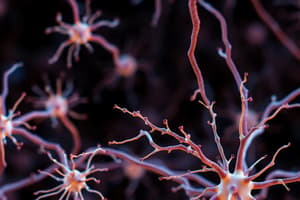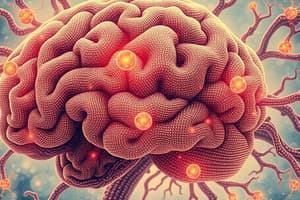Podcast
Questions and Answers
Which part of a neuron is primarily responsible for transmitting impulses away from the cell body?
Which part of a neuron is primarily responsible for transmitting impulses away from the cell body?
- Nissl’s granules
- Cell body
- Dendrites
- Axon (correct)
What type of neuron has one axon and two or more dendrites?
What type of neuron has one axon and two or more dendrites?
- Bipolar neuron
- Multipolar neuron (correct)
- Unipolar neuron
- None of the above
What is composed of Schwann cells and forms a myelin sheath around certain axons?
What is composed of Schwann cells and forms a myelin sheath around certain axons?
- Myelinated nerve fibres (correct)
- Nissl’s granules
- Dendrites
- Nodes of Ranvier
What type of neural organization is characterized by having a brain and ganglia present?
What type of neural organization is characterized by having a brain and ganglia present?
Where are unipolar neurons commonly found?
Where are unipolar neurons commonly found?
What connects the axon of one neuron to the dendrites of another neuron?
What connects the axon of one neuron to the dendrites of another neuron?
Which structure in neurons contains organelles and Nissl’s granules?
Which structure in neurons contains organelles and Nissl’s granules?
What forms the gaps between two adjacent myelin sheaths on myelinated nerve fibers?
What forms the gaps between two adjacent myelin sheaths on myelinated nerve fibers?
Which type of axon is characterized by the absence of a myelin sheath?
Which type of axon is characterized by the absence of a myelin sheath?
What type of neurotransmitters are contained in synaptic vesicles?
What type of neurotransmitters are contained in synaptic vesicles?
Flashcards are hidden until you start studying
Study Notes
Structure of the Neural System
- All animals possess a neural system composed of neurons, specialized cells for detecting, receiving, and transmitting stimuli.
- Lower invertebrates, such as Hydra, exhibit a simple neural organization characterized by a network of neurons.
- Insects have a more organized neural system featuring a brain, ganglia, and distinct neural tissues.
- Vertebrates demonstrate a highly developed neural system.
Neuron Composition
- Neurons consist of three primary parts: cell body, dendrites, and axon.
- The cell body contains cytoplasm, typical cell organelles, and Nissl's granules, which are granular bodies associated with protein synthesis.
- Dendrites are short, branching fibers that transmit impulses toward the cell body and also contain Nissl’s granules.
- The axon is a long fiber that transmits nerve impulses away from the cell body, ending in bulb-like structures called synaptic knobs.
Synaptic Transmission
- Synaptic knobs contain synaptic vesicles filled with neurotransmitters, which facilitate communication between neurons at synapses or neuro-muscular junctions.
Neuron Classification
- Neurons are classified based on the number and arrangement of axons and dendrites:
- Multipolar neurons have one axon and multiple dendrites, commonly found in the cerebral cortex.
- Bipolar neurons consist of one axon and one dendrite, typically located in the retina of the eye.
- Unipolar neurons possess a single axon, predominantly seen in embryonic stages.
Axon Types
- Two types of axons exist: myelinated and unmyelinated.
- Myelinated axons are enveloped by Schwann cells forming a myelin sheath, which increases impulse transmission speed.
- The gaps between adjacent myelin sheaths are called nodes of Ranvier.
- Myelinated nerve fibers are prevalent in spinal and cranial nerves.
- Unmyelinated axons are enclosed by Schwann cells without forming a myelin sheath, primarily found in the autonomic and somatic nervous systems.
Studying That Suits You
Use AI to generate personalized quizzes and flashcards to suit your learning preferences.




